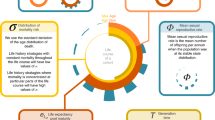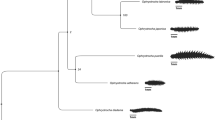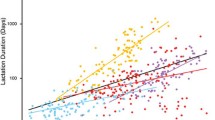Abstract
Traditionally, biological times (gestation period, longevity) are proposed to scale to body mass M as M0.25. Although phylogeny-informed statistics have become widespread, it is still sometimes assumed that in datasets comprising a very large number of species, analyses that do not and that do account for phylogeny will yield similar results. Here we show, in a large dataset on gestation period length in eutherian mammals (1214 species from 20 orders), that the allometric scaling exponent is about twice as high using conventional statistics (ordinary least squares OLS, M0.18–020) as when using phylogenetic generalised least squares (PGLS, M007-010), indicating that among closely related taxa, the scaling of gestation is much lower than generally assumed. This matches the well-known absence of scaling among different-sized breeds of domestic animal species, and indicates that changes in M must be more related to changes in development speed rather than development time among closely related species, which has implications for interpreting life history-consequences of insular dwarfism and gigantism. Only when allowing just one species per order (simulated in 100 randomised datasets of n = 20 species across 20 orders) is 0.25 included in the scaling exponent confidence interval in both OLS and PGLS. Differences in scaling at different taxonomic levels in comparative datasets may indicate evolutionary trends where successive taxonomic groups compete by fundamental variation in organismal design not directly linked to changes in M. Allometries then do not necessarily represent universal scaling rules, but snapshots of evolutionary time that depend on diversification and extinction events before the picture was taken. It is either by analysing subsets separately, or by using PGLS in large datasets, that the underlying relationships with M can then be unveiled.
Similar content being viewed by others
References
Amoah, EA, Gelaye, S., Guthrie, P., Rexroad, C.E., 1996. Breeding season and aspects of reproduction of female goats. J. Anim. Sci. 74, 723–728.
Andersen, H., Plum, M., 1965. Gestation length and birth weight in cattle and buffaloes: a review. J. Dairy Sci. 48, 1224–1235.
Baker, R.H., 2002. Comparative methods. In: DeSalle, R., Giribet, G., Wheeler, W. (Eds.), Techniques in Molecular Systematics and Evolution. Birkhäuser Verlag, Basel, pp. 146–161.
Benton, M.J., Csiki, Z., Grigorescu, D., Redelstorff, R., Sander, P.M., Stein, K., Weishampel, D.B., 2010. Dinosaurs and the island rule: the dwarfed dinosaurs from Hateg Island. Palaeogeogr. Palaeoclimatol. Palaeoecol. 293, 438–454.
Bernstein, R.M., 2010. The big and the small of it: how body size evolves. Yearb. Phys. Anthropol. 53, 46–62.
Bininda-Emonds, O.R.P., Cardillo, M., Jones, K.E., MacPhee, R.D.E., Beck, R.M.D., Grenyer, R., Price, S.A., Vos, R.A., Gittleman, J.L., Purvis, A., 2007. The delayed rise of present-day mammals. Nature 446, 507–512.
Bininda-Emonds, O.R.P., Cardillo, M., Jones, K.E., MacPhee, R.D.E., Beck, R.M.D., Grenyer, R., Price, S.A., Vos, R.A., Gittleman, J.L, Purvis, A., 2008. Corrigendum: The delayed rise of present-day mammals. Nature 456, 274.
Bonner, J.T., 2006. Why Size Matters. Princeton University Press, Princeton.
Bos, H., Van der Mey, G.J.W., 1980. Length of gestation periods of horses and ponies belonging to different breeds. Livest. Prod. Sci. 7, 181–187.
Bradford, G.E., Hart, R., Quirke, J.F., Land, R.B., 1972. Genetic control of the duration of gestation in sheep. J. Reprod. Fertil. 30, 459–463.
Brown, J.H., Gillooly, J.F., Allen, A.P., Savage, V.M., West, G.B., 2004. Towards a metabolic theory of ecology. Ecology 85, 1771–1789.
Brown, J.H., Sibly, R.M., Kodric-Brown, A., 2012. Introduction: metabolism as the basis for a theoretical unification of ecology. In: Sibly, R.M., Brown, J.H., Kodric-Brown, A. (Eds.), Metabolic Ecology. A Scaling Approach. Wiley-Blackwell, Chichester, UK, pp. 1–6.
Calder, W.A., 1984. Size, Function, and Life History. Harvard University Press, Cambridge, MA.
Capellini, I., Venditi, C, Barton, R.A., 2010. Phylogenyand metabolic scaling in mammals. Ecology 91, 2783–2793.
Carvalho, P., Diniz-Filho, J., Bini, L., 2006. Factors influencing changes in trait correlations across species after using phylogenetic independent contrasts. Evol. Ecol. 20, 591–602.
Crew, F.A.E., 1923. The significance of an achondroplasia-like condition met with in cattle. Proc. R. Soc. Lond. B 95, 228–255.
Dirks, W., Bromage, T.G., Agenbroad, L.D., 2012. The duration and rate of molar plate formation in Palaeoloxodon cypriotes and Mammuthus columbi from dental histology. Quatern. Int. 255, 79–85.
Dubman, E., Collard, M., Mooers, A.Ø., 2012. Evidence that gestation duration and lactation duration are coupled traits in primates. Biol. Lett. 8, 998–1001.
Egset, C.K., ansen, T.F., Le Rouzic, A., Bolstad, G.H., Rosenqvist, G., Pélabon, C, 2012. Artificial selection on allometry: change in elevation but not slope. J. Evol. Biol. 25, 938–948.
Freckleton, R.P., Harvey, P.H., Pagel, M., 2002. Phylogenetic analysis and comparative data: a test and review of evidence. Am. Nat. 160, 712–726.
Fritz, J., Hummel, J., Kienzle, E., Arnold, C, Nunn, C, Clauss, M., 2009. Comparative chewing efficiency in mammalian herbivores. Oikos 118, 1623–1632.
Geist, V., 1966. The evolution of horn-like organs. Behaviour 27, 175–214.
Grange, S., Duncan, P., 2006. Bottom-up and top-down processes in African ungulate communities: resources and predation acting on the relative abundance of zebra and grazing bovids. Ecography 29, 899–907.
Grange, S., Duncan, P., Gaillard, J.-M., Sinclair, A.R.E., Gogan, P.J.P., Packer, C, Heribert, H., East, M., 2004. What limits the Serengeti zebra population? Oecologia 140, 523–532.
Hamilton, M.J., Davidson, A.D., Sibly, R.M., Brown, J.H., 2011. Universal scaling of production rates across mammalian lineages. Proc. R. Soc. Lond. B 278, 560–566.
Harvey, P.H., Pagel, M.D., 1991. The Comparative Method in Evolutionary Biology. Oxford University Press, Oxford.
Hennemann, W.W., 1984. Intrinsic rates of natural increase of altricial and precocial eutherian mammals: the potential price of precociality. Oikos 43, 363–368.
Jollans, J.L., 1960. A study of the West African dwarf sheep in the closed forest zone of Ashanti. West Afr. J. Biol. Chem. 3, 74–80.
Jones, K.E., Purvis, A., 1997. An optimum body size for mammals? Comparative evidence from bats. Funct. Ecol. 11, 751–756.
Jones, K.E., Bielby, J., Cardillo, M., Fritz, S.A., O’Dell, J., Orme, CD., Safi, K., Sechrest, W., Boakes, E.H., Carbone, C, Connolly, C, Cutts, M.J., Foster, J.K., Grenyer, R., Habib, M., Plaster, C.A., Price, S.A., Rigby, E.A., Rist, J., Teacher, A., Bininda-Emonds, O.R.P., Gittleman, J.L., Mace, G.M., Purvis, A., 2009. PanTHERIA: a species-level database of life history, ecology, and geography of extant and recently extinct mammals. Ecology 90, 2648 (Ecological Archives E2090–2184).
Jordana, X., Köhler, M., 2011. Enamel microstructure in the fossil bovid Myotragus balearicus (Majorca, Spain): implications for life-history evolution of dwarf mammals in insular ecosystems. Palaeogeogr. Palaeoclimatol. Palaeoecol. 300, 59–66.
Jordana, X., Marín-Moratalla, N., DeMiguel, D., Kaiser, T.M., Köhler, M., 2012. Evidence of correlated evolution of hypsodonty and exceptional longevity in endemic insular mammals. Proc. R. Soc. Lond. B 279, 3339–3346.
Kihlström, J.E., 1972. Period of gestation and body weight in some placental mammals. Comp. Biochem. Physiol. A 43, 673–679.
King Wilson, W., Dudley, F.J., 1952. The duration of gestation in rabbit breeds and crosses. J. Genet. 50, 384–391.
Kirkwood, J.K., 1985. The influence of size on the biology of the dog. J. Small Anim. Pract. 26, 97–110.
Köhler, M., Moyà-Solà, S., 2009. Physiological and life history strategies of a fossil large mammal in a resource-limited environment. Proc. Natl. Acad. Sci. U. S. A. 106, 20354–20358.
Kozlowski, J., Weiner, J., 1997. Interspecific allometries are by-products of body size optimization. Am. Nat. 149, 352–380.
Lindstedt, S.L, Calder, W.A.I., 1981. Body size, physiological time and longevity of homeothermic animals. Q. Rev. Biol. 56, 1–16.
Martin, R.D., MacLarnon, A.M., 1985. Gestation period, neonatal size and maternal investment in placental mammals. Nature 313, 220–223.
Martin, R.D., Genoud, M., Hemelrijk, C.K., 2005. Problems of allometric scaling analysis: examples from mammalian reproductive biology. J. Exp. Biol. 208, 1731–1747.
Meiri, S., Raia, P., 2010. Reptilian all the way? Proc. Natl. Acad. Sci. U. S. A. 107, E27.
Müller, D.W.H., Codron, D., Werner, J., Fritz, J., Hummel, J., Griebeler, E.M., Clauss, M., 2012. Dichotomy of eutherian reproduction and metabolism. Oikos 121, 102–115.
Müller, D.W.H., Codron, D., Meloro, C, Munn, A., Schwarm, A., Hummel, J., Clauss, M., 2013. Assessing the Jarman-Bell principle: scaling of intake, digestibility, retention time and gut fill with body mass in mammalian herbivores. Comp. Biochem. Physiol. A 164, 129–140.
Müller, D.W.H., Zerbe, P., Codron, D., Clauss, M., Hatt, J.-M., 2011. A long life among ruminants: giraffids and other special cases. Schweiz. Arch. Tierheilkd. 153, 515–519.
Nunn, C.L., 2011. The Comparative Approach in Evolutionary Anthropology and Biology. University of Chicago Press, Chicago.
Orme, D., Freckleton, R., Thomas, G., Petzoldt, T., Fritz, S., Isaac, N., 2010. Caper: comparative analyses of phylogenetics and evolution in R. R package version 04/r71. See http://wwwR-ForgeR-projectorg/projects/caper/
Pagel, M., 1999. Inferring the historical patterns of biological evolution. Nature 401, 877–884.
Palombo, M.R., 2007. How can endemic proboscideans help us understand the “island rule”? A case study of Mediterranean islands. Quatern. Int. 169/170, 105–124.
Paradis, E., Claude, J., Strimmer, K., 2004. APE: analyses of phylogenetics and evolution in R language. Bioinformatics 20, 289–290.
Peters, R.H., 1983. The Ecological Implications of Body Size. Cambridge University Press, Cambridge.
Pinheiro, J., Bates, D., DebRoy, S., Sarkar, D., R Development Core Team, 2011. Nlme: linear and nonlinear mixed effects models. R package version 31–102. Available at http://cranrprojectorg/web/packages/nlme/citationhtml
Raia, P., Barbera, C, Conte, M., 2003. The fast life of a dwarfed giant. Evol. Ecol. 15, 293–312.
Revell, L.J., 2010. Phylogenetic signal and linear regression on species data. Methods Ecol. Evol. 1, 319–329.
Revell, L.J., 2012. Phytools: an R package for phylogenetic comparative biology (and other things). Methods Ecol. Evol. 3, 217–223.
Ricklefs, R.E., Starck, J.M., 1996. Applications of phylogenetically independent contrasts: a mixed progress report. Oikos 77, 167–172.
Roth, V.L., 1990. Island dwarf elephants: a case study in body mass estimatio and ecological inference. In: Damuth, J., MacFadden, J.B. (Eds.), Body Size in Mammalian Paleobiology. Cambridge University Press, New York, pp. 51–179.
Roth, V.L, 1992. Inferences from allometry and fossils: dwarfing elephant on islands. In: Futuyma, D., Antonovics, J. (Eds.), Oxford Surveys in Evolutionary Biology, vol. 8. Oxford University Press, New York, pp. 259–288.
Sander, P.M., Klein, N., Buffetaut, E.,Cuny, G., Suteethorn, V., Le Loeuff, J., 2004. Adaptive radiation in sauropod dinosaurs: bone histology indicates rapid evolution of giant body size through acceleration. Organ. Divers. Evol. 4, 165–173.
Sander, P.M., Mateus, O., Laven, T., Knötschke, N., 2006. Bone histology indicates insular dwarfism in a new Late Jurassic sauropod dinosaur. Nature 441, 739–741.
Schmidt-Nielsen, K., 1984. Scaling: Why is Animal Size so Important? Cambridge University Press, Cambridge.
Sibly, R.M., 2012. Life history. In: Sibly, R.M., Brown, J.H., Kodric-Brown, A. (Eds.), Metabolic Ecology. A Scaling Approach. Wiley-Blackwell, Chichester, UK, pp. 57–66.
Sibly, R.M., Brown, J.H., Kodric-Brown, A. (Eds.), 2012. Metabolic Ecology. A Scaling Approach. Wiley-Blackwell, Chichester, UK.
Sieg, A.E., O’Connor, M.P., McNair, J.N., Grant, B.W., Agosta, S.J., Dunham, A.E., 2009. Mammalian metabolic allometry: do intraspecific variation, phylogeny, and regression models matter? Am. Nat. 174, 720–733.
Stein, K., Csiki, Z., Curry Rogers, K., Weishampel, D.B., Redelstorff, R., Carballido, J.L., Sander, P.M., 2010. Small body size and extreme cortical bone remodeling indicate phyletic dwarfism in Magyarosaurus dacus (Sauropoda: Titanosauria). Proc. Natl. Acad. Sci. U. S. A. 107, 9258–9263.
Team RDC, 2011. R: A Language and Environment for Statistical Computing. R Foundation for Statistical Computing, Vienna, Austria, ISBN 3-900051-07-0 http://wwwR-projectorg/
Western, D., 1979. Size, life history and ecology in mammals. Afr. J. Ecol. 17, 185–204.
White, C.R., Blackburn, T.M., Seymour, R.S., 2009. Phylogenetically informed analysis of the allometry of mammalian basal metabolic rate supports neither geometric nor quarter-power scaling. Evolution 63, 2658–2667.
White, E.P., Xiao, X., Isaac, N.J.B., Sibly, R.M., 2012. Methodological tools. In: Sibly, R.M., Brown, J.H., Kodric-Brown, A. (Eds.), Metabolic Ecology. A Scaling Approach. Wiley-Blackwell, Chichester, UK, pp. 9–20.
Zerbe, P., Clauss, M., Codron, D., Bingaman Lackey, L., Rensch, E., Streich, W.J., Hatt, J.M., Müller, D.H.W., 2012. Reproductive seasonality in captive wild ruminants: implications for biogeographical adaptation, photoperiodic control, and life history. Biol. Rev. 87, 965–990.
Author information
Authors and Affiliations
Corresponding author
Rights and permissions
About this article
Cite this article
Clauss, M., Dittmann, M.T., Müller, D.W.H. et al. Low scaling of a life history variable: Analysing eutherian gestation periods with and without phylogeny-informed statistics. Mamm Biol 79, 9–16 (2014). https://doi.org/10.1016/j.mambio.2013.01.002
Received:
Accepted:
Published:
Issue Date:
DOI: https://doi.org/10.1016/j.mambio.2013.01.002




